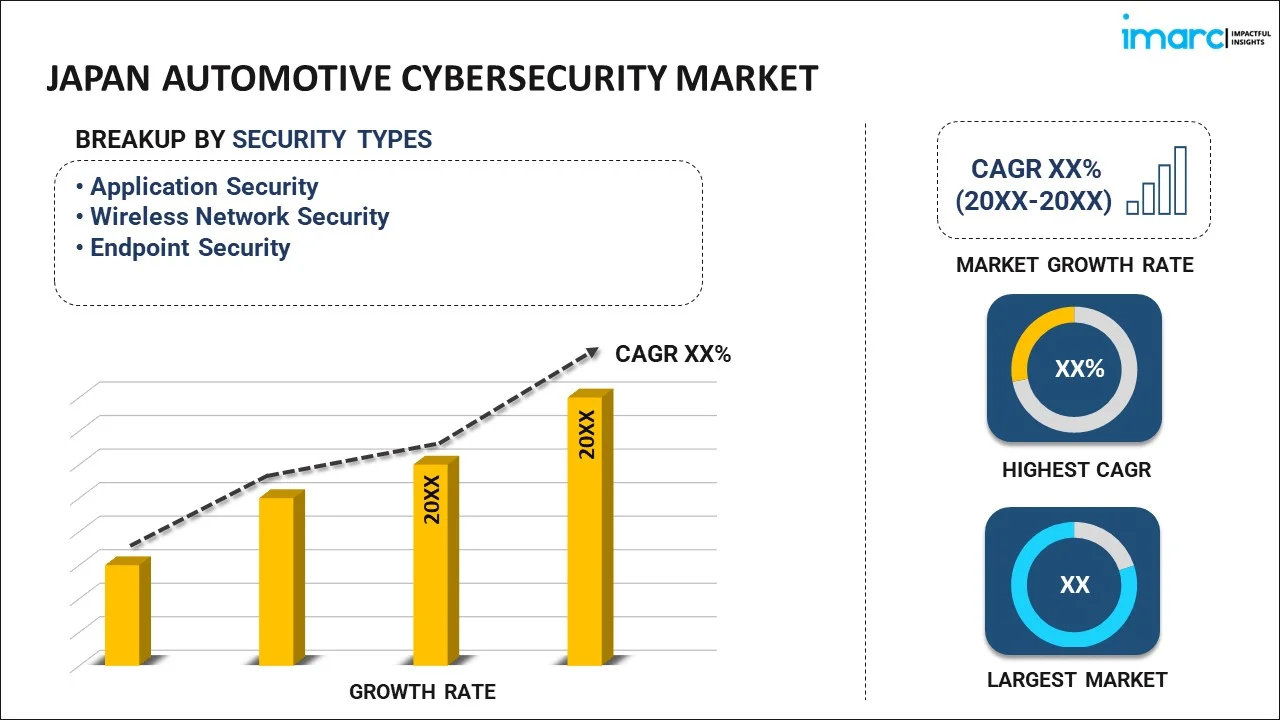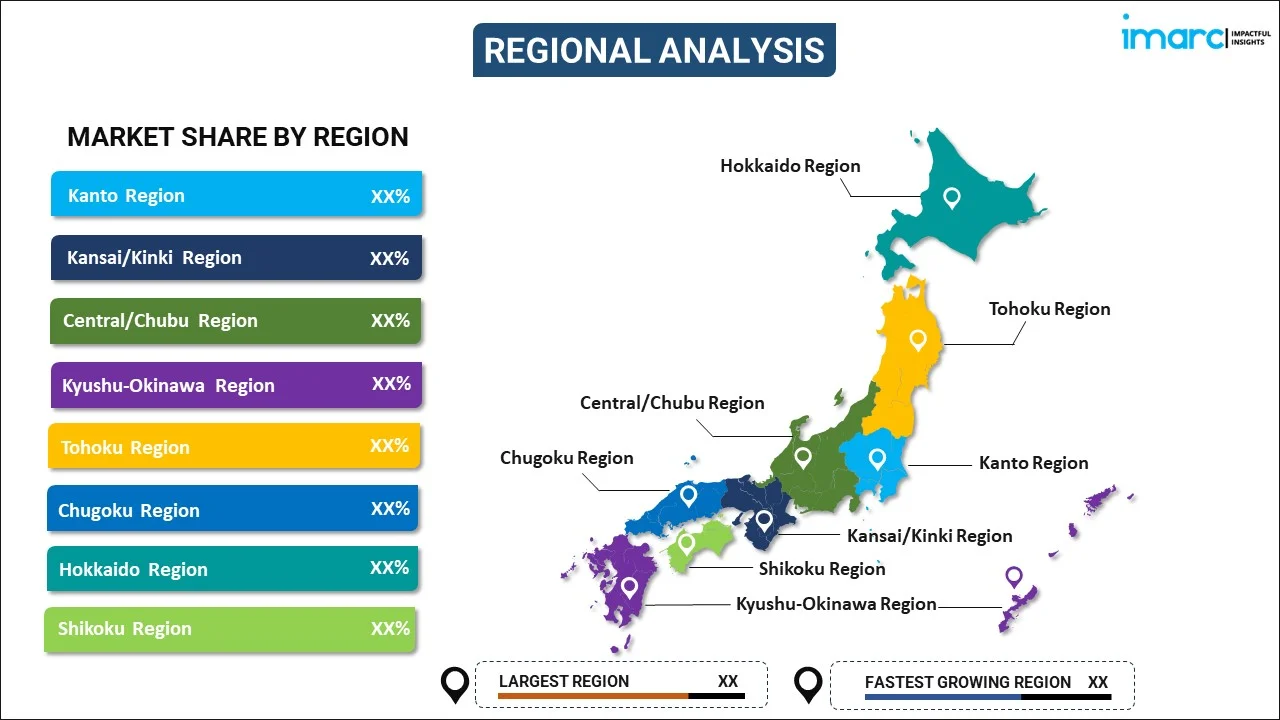
Japan Automotive Cybersecurity Market Report by Security Type (Application Security, Wireless Network Security, Endpoint Security), Form (In-Vehicle, External Cloud Services), Vehicle Type (Passenger Car, Commercial Vehicle, Electric Vehicle), Application (ADAS and Safety, Body Control and Comfort, Infotainment, Telematics, Powertrain Systems, and Others), and Region 2025-2033
Market Overview:
Japan automotive cybersecurity market size reached USD 219.0 Million in 2024. Looking forward, IMARC Group expects the market to reach USD 795.0 Million by 2033, exhibiting a growth rate (CAGR) of 15.4% during 2025-2033. The increasing demand for connected cars and the Internet of Things (IoT) in the automotive industry, which has significantly expanded the attack surface for cyber threats, is primarily driving the market.
|
Report Attribute
|
Key Statistics
|
|---|---|
|
Base Year
|
2024 |
|
Forecast Years
|
2025-2033
|
|
Historical Years
|
2019-2024
|
| Market Size in 2024 | USD 219.0 Million |
| Market Forecast in 2033 | USD 795.0 Million |
| Market Growth Rate (2025-2033) | 15.4% |
Automotive cybersecurity refers to the measures and practices employed to protect the electronic systems and data within modern vehicles from cyber threats and unauthorized access. As vehicles become increasingly connected and reliant on software-driven technologies, they become vulnerable to hacking and cyberattacks. Automotive cybersecurity involves implementing robust security protocols, encryption, and intrusion detection systems to safeguard critical functions such as engine control, braking, and infotainment systems. This field addresses the potential risks associated with vehicle hacking, which can have severe consequences, including remote control of a vehicle's functions, data theft, and compromising passenger safety. Cybersecurity experts work to identify vulnerabilities, regularly update software, and develop safeguards to defend against emerging threats. Governments and industry standards organizations also play a role in setting guidelines and regulations to ensure that automakers prioritize cybersecurity in vehicle design and production. Ultimately, automotive cybersecurity is essential to ensure the safety, privacy, and reliability of modern vehicles in an increasingly interconnected world.
Japan Automotive Cybersecurity Market Trends:
The automotive cybersecurity market in Japan is witnessing significant growth due to a multitude of driving factors. Firstly, the proliferation of connected vehicles has surged, connecting cars to the internet and other devices, creating an extensive attack surface. Consequently, this increased connectivity necessitates robust cybersecurity measures to protect against potential threats. Additionally, the growing adoption of advanced driver-assistance systems (ADAS) and autonomous driving technologies plays a pivotal role in propelling the demand for automotive cybersecurity solutions. As these systems become more prevalent, they rely on complex software and communication networks, making them susceptible to cyberattacks. Moreover, stringent government regulations and industry standards are compelling automakers to prioritize cybersecurity in their vehicles. This includes regulations like ISO/SAE 21434 and UN R155, which mandate cybersecurity requirements for automotive manufacturers. Furthermore, the rising awareness among consumers about the vulnerabilities of connected vehicles is driving the market, as customers increasingly demand vehicles that prioritize safety and security. In conclusion, the automotive cybersecurity market in Japan is expected to be driven by the surge in connected vehicles, the integration of advanced technologies, regulatory mandates, and consumer awareness.
Japan Automotive Cybersecurity Market Segmentation:
IMARC Group provides an analysis of the key trends in each segment of the market, along with forecasts at the country level for 2025-2033. Our report has categorized the market based on security type, form, vehicle type, and end user.
Security Type Insights:

- Application Security
- Wireless Network Security
- Endpoint Security
The report has provided a detailed breakup and analysis of the market based on the security type. This includes application security, wireless network security, and endpoint security.
Form Insights:
- In-Vehicle
- External Cloud Services
A detailed breakup and analysis of the market based on the form have also been provided in the report. This includes in-vehicle and external cloud services.
Vehicle Type Insights:
- Passenger Car
- Commercial Vehicle
- Electric Vehicle
The report has provided a detailed breakup and analysis of the market based on the vehicle type. This includes passenger car, commercial vehicle, and electric vehicle.
Application Insights:
- ADAS and Safety
- Body Control and Comfort
- Infotainment
- Telematics
- Powertrain Systems
- Others
A detailed breakup and analysis of the market based on the application have also been provided in the report. This includes ADAS and safety, body control and comfort, infotainment, telematics, powertrain systems, and others.
Regional Insights:

- Kanto Region
- Kansai/Kinki Region
- Central/ Chubu Region
- Kyushu-Okinawa Region
- Tohoku Region
- Chugoku Region
- Hokkaido Region
- Shikoku Region
The report has also provided a comprehensive analysis of all the major regional markets, which include Kanto Region, Kansai/Kinki Region, Central/ Chubu Region, Kyushu-Okinawa Region, Tohoku Region, Chugoku Region, Hokkaido Region, and Shikoku Region.
Competitive Landscape:
The market research report has also provided a comprehensive analysis of the competitive landscape. Competitive analysis such as market structure, key player positioning, top winning strategies, competitive dashboard, and company evaluation quadrant has been covered in the report. Also, detailed profiles of all major companies have been provided.
Japan Automotive Cybersecurity Market Report Coverage:
| Report Features | Details |
|---|---|
| Base Year of the Analysis | 2024 |
| Historical Period | 2019-2024 |
| Forecast Period | 2025-2033 |
| Units | Million USD |
| Scope of the Report | Exploration of Historical and Forecast Trends, Industry Catalysts and Challenges, Segment-Wise Historical and Predictive Market Assessment:
|
| Security Types Covered | Application Security, Wireless Network Security, Endpoint Security |
| Forms Covered | In-Vehicle, External Cloud Services |
| Vehicle Types Covered | Passenger Car, Commercial Vehicle, Electric Vehicle |
| Applications Covered | ADAS and Safety, Body Control and Comfort, Infotainment, Telematics, Powertrain Systems, Others |
| Regions Covered | Kanto Region, Kansai/Kinki Region, Central/ Chubu Region, Kyushu-Okinawa Region, Tohoku Region, Chugoku Region, Hokkaido Region, Shikoku Region |
| Customization Scope | 10% Free Customization |
| Post-Sale Analyst Support | 10-12 Weeks |
| Delivery Format | PDF and Excel through Email (We can also provide the editable version of the report in PPT/Word format on special request) |
Key Questions Answered in This Report:
- How has the Japan automotive cybersecurity market performed so far and how will it perform in the coming years?
- What has been the impact of COVID-19 on the Japan automotive cybersecurity market?
- What is the breakup of the Japan automotive cybersecurity market on the basis of security type?
- What is the breakup of the Japan automotive cybersecurity market on the basis of form?
- What is the breakup of the Japan automotive cybersecurity market on the basis of vehicle type?
- What is the breakup of the Japan automotive cybersecurity market on the basis of application?
- What are the various stages in the value chain of the Japan automotive cybersecurity market?
- What are the key driving factors and challenges in the Japan automotive cybersecurity?
- What is the structure of the Japan automotive cybersecurity market and who are the key players?
- What is the degree of competition in the Japan automotive cybersecurity market?
Key Benefits for Stakeholders:
- IMARC’s industry report offers a comprehensive quantitative analysis of various market segments, historical and current market trends, market forecasts, and dynamics of the Japan automotive cybersecurity market from 2019-2033.
- The research report provides the latest information on the market drivers, challenges, and opportunities in the Japan automotive cybersecurity market.
- Porter's five forces analysis assist stakeholders in assessing the impact of new entrants, competitive rivalry, supplier power, buyer power, and the threat of substitution. It helps stakeholders to analyze the level of competition within the Japan automotive cybersecurity industry and its attractiveness.
- Competitive landscape allows stakeholders to understand their competitive environment and provides an insight into the current positions of key players in the market.
Need more help?
- Speak to our experienced analysts for insights on the current market scenarios.
- Include additional segments and countries to customize the report as per your requirement.
- Gain an unparalleled competitive advantage in your domain by understanding how to utilize the report and positively impacting your operations and revenue.
- For further assistance, please connect with our analysts.
 Inquire Before Buying
Inquire Before Buying
 Speak to an Analyst
Speak to an Analyst
 Request Brochure
Request Brochure
 Request Customization
Request Customization




.webp)




.webp)












